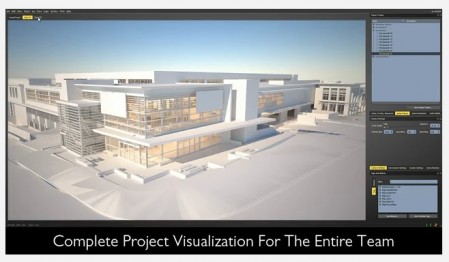Continued from page 1
Some Highlights of VEO
To utilize VEO you export out from your BIM (right now that only includes Revit) the data subset you want to push to VEO. Part of VEO’s focus is that you simplify model sharing by focusing on publishing out only revision-specific information. You are also able to review proposed revisions and evaluate options before publishing to the entire team or incorporating those changes.
A strong and important aspect of VEO is that it has tracking for all the changes that are made. It understands the history and context of every revision. You can actually rewind to any date or date range and highlight every change made at that specific date (see images 02).
VEO is also able to allow the user to create custom database tables and share them. You can access, update or share data and documents from within the office or in the field (say iPad) with or without an Internet connection. The company says the iPad app and Excel plugin are coming soon. So those are not yet available today.
VEO also has cloud-rendering and the images we have captured from their videos look pretty good. (see image 04) Lastly, the final item we would like to mention is that VEO has clash-detection and users can create run sets for clash rules.
Closing Details
You can try VEO for free and the kit comes with the installer for the software and a building and tutorial project. There are training manuals and videos that quickly get folks up and running. The trial is free.
M-SIX has already detailed its pricing plans and the options fall into two categories. A per user license is 250.USD per user per month. With that model you get unlimited projects and 25 GB of storage. A per project license is 2,500.USD per month and with that model you get unlimited concurrent users and 500 GB of storage. You also get various compute hours with those plans. You can read the pricing here.
Ultimately what the M-SIX folks want you to understand is that VEO is a platform for BIM. The platform was architected to address what is wrong with the BIM workflow bottlenecks that exist today. To learn more visit them online here: http://www.M-SIX.com/
Architosh Analysis
First off, we’ve known about the VEO project since 2010 when we published our BIM report. We too have been anxiously awaiting to see what VEO would be in the end as we were told it was really BIM platform agnostic but itself wasn’t another multi-platform BIM authoring package. Indeed, VEO is not a BIM authoring package but rather a BIM platform which addresses a core aspect of the BIM revolution within AEC. That aspect is that BIM is actually a process change rather than a software technology change.
Before folks get super excited about VEO for Mac OS X we would caution readers to consider the long list of “plans” statements by companies in the CAD and 3D industry. About ten years ago we published a news report quoting Revit manager Richard Rundell AIA who told us privately that Revit was built from the ground-up to be highly portable and that plans for Revit were not only important but doable. That never happened. And while Revit for Mac may indeed be imminent (and we know nothing official) many BIM users and OS X fans wait patiently.
We have heard statements about native Mac versions of many things over the years and still they always seem to be plans out in the distant horizon. With that word of caution let’s also state that M-SIX is a brand new BIM company and they deserve optimism and praise for their implementation of iOS in their mobility and cloud strategy. Those who are interested in VEO and want to see it on OS X should simply tell them that and then download and use the product on Windows if they can. That is the best way to assure funding for OS X in the future.




Reader Comments
Comments for this story are closed